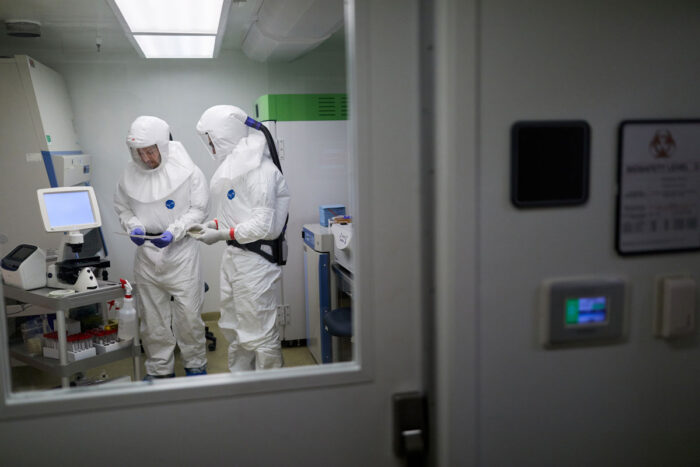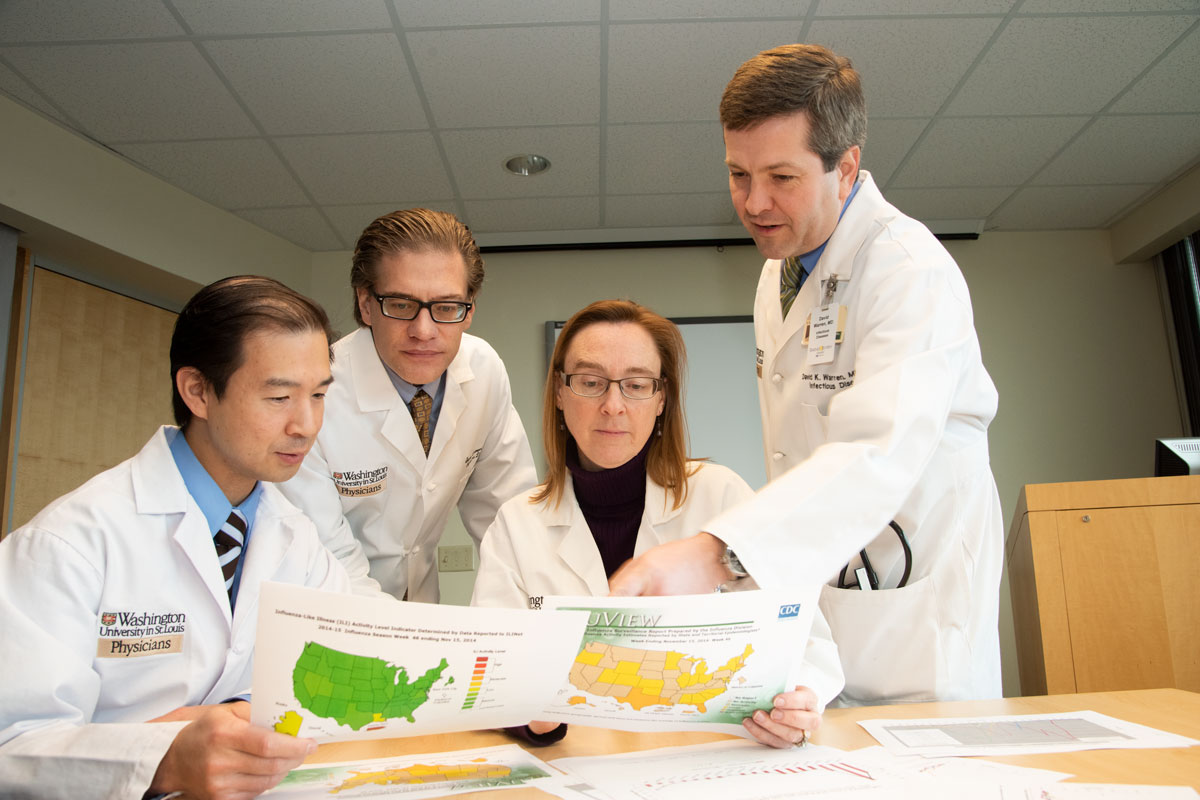School of Medicine physicians, researchers tackle coronavirus
Clinical teams ready; research for vaccines, drugs underway

Postdoctoral researchers Brett Case, PhD, (left) and Adam Bailey, MD, PhD, wear full personal protective equipment to study the COVID-19 virus. Washington University School of Medicine in St. Louis physicians and researchers are preparing for COVID-19 cases and working on drugs and vaccines to fight the disease.
Soon after a novel coronavirus first appeared in China in late 2019, researchers, doctors and staff at Washington University School of Medicine in St. Louis began preparing for the possibility of an outbreak. Infectious disease physicians started planning how to respond if a person with suspected exposure to the virus arrived on campus, and researchers set to work finding drugs or vaccines to treat or prevent COVID-19, the name given to the illness caused by the virus.
“New infectious diseases emerge every so often, and we have to be vigilant,” said Steven J. Lawrence, MD, an associate professor of medicine. “Over the last few decades we’ve had HIV, Ebola, SARS, Zika and now COVID-19. Such diseases usually arise when an animal virus manages to jump into people because of close contact between people and animals. The chance of preventing that happening anywhere in the world is probably zero. What we can do is be prepared to respond as rapidly as possible when it happens.”
In December, China reported the first cases of a mysterious illness characterized by fever, a dry cough and difficulty breathing. Within weeks, Chinese scientists had identified the cause as a never-before-seen member of the coronavirus family. Coronaviruses typically cause mild infections such as the common cold. But in 2002, a newly emerged strain of coronavirus caused an outbreak of severe acute respiratory syndrome (SARS) that killed nearly 1,000 people before it was contained.
It quickly became evident that the 2019 coronavirus strain, named SARS-CoV-2, was more like SARS than the common cold. By late January, tens of thousands of people in China were infected. At the time, the only cases in the U.S. were believed to be in people who had been infected while traveling in China.
“In January and February, we had a brief moment of opportunity to contain this outbreak in the U.S. by knowing where people had traveled,” Lawrence said. “That’s why the efforts to identify and isolate people with the virus were so robust, even though we had such few cases. Once the virus started spreading from person to person in the U.S., it became much, much more complicated.”
Hilary M. Babcock, MD, a professor of medicine and medical director of the Infection Prevention and Epidemiology Consortium for BJC HealthCare, and David K. Warren, MD, a professor of medicine and the medical director for infection prevention at Barnes-Jewish Hospital, did not wait for the virus to start spreading in the U.S. In January, they established a virtual incident command center at BJCHealthCare and called twice-weekly meetings to develop a coronavirus outbreak response plan for all BJC hospitals, including hospitals and clinics staffed by Washington University physicians. The team started by dusting off a plan developed in 2002 for SARS and adapting it to COVID-19 as more information emerged.
The data on mortality for COVID-19 remains a moving target and continues to be assessed. So far, people who are older and those with underlying health conditions, such as heart disease, lung disease or with compromised immune systems, have a higher risk of death. Early data suggests that the illness is more deadly than seasonal flu. Like SARS and the flu, COVID-19 spreads easily through droplets released when infected people cough or sneeze. The virus’s contagiousness means that proper use of personal protective equipment is crucial to protect health professionals caring for coronavirus patients.
“Communication is one of the most important tools at a time like this,” Babcock said. “We needed to make sure that our front-line clinicians can very quickly recognize that someone might be infected, and that they know what to do if a potentially infected person presents at their clinic. We also developed guidance regarding which personal protective equipment to wear when working with a patient suspected of having COVID-19 – mask, gloves, eye shield, respiratory equipment, and gown – how to put it on so it is most effective, and, most importantly, how to take it off without contaminating yourself.”
Babcock and Warren also are keeping a close watch on outbreaks in other countries and implemented new travel screening recommendations across the university as the virus has spread to other countries, notably South Korea, Italy and Iran.
“We are ready,” Babcock said. “We’ve been ready for weeks. It’s only a matter of time before we get our first case.”
Building the toolkit to fight COVID-19
Across campus, a team led by Sean Whelan, PhD, the Marvin A. Brennecke Distinguished Professor and head of the Department of Molecular Microbiology, and Michael S. Diamond, MD, PhD, the Herbert S. Gasser Professor of Medicine, is looking for ways to treat COVID-19 or reduce its spread.
“We had a discussion in early January and decided then to work on advancing therapeutics and vaccines for coronavirus, because it had the potential to be a significant problem,” said Whelan, who took over as head of the molecular microbiology department on Jan. 1. “It is our responsibility as part of the biomedical research community to do this. The consequences of this virus in places where there isn’t a good health-care system could be dire.”
Whelan called weekly meetings to coordinate the School of Medicine coronavirus research effort. He and Diamond have special expertise in emerging viral infections. Diamond led the School of Medicine response to Zika virus, during which he and others developed a mouse model of Zika infection and identified an antibody that is now used as part of a diagnostic test. While on the faculty at Harvard, Whelan studied Ebola and identified a critical protein that the virus exploits to cause deadly infections.
Whelan and Diamond built a research team including influenza experts Jacco Boon, PhD, an associate professor of medicine, and Ali Ellebedy, PhD, an assistant professor of pathology and immunology, who provided advice and scientific tools for studying respiratory viruses; structural immunologist Daved Fremont, PhD, a professor of pathology and immunology, who has begun studying the interactions of coronavirus proteins with antibodies and other human proteins to facilitate vaccine design and improved diagnostics; David T. Curiel, MD, PhD, the Distinguished Professor of Radiation Oncology, who began designing a potential vaccine; and Siyuan Ding, PhD, an assistant professor of molecular microbiology, who is investigating whether the virus also can be transmitted through the fecal-oral route.
The team is analyzing the structure of the virus’s proteins to find possible targets for drugs or vaccines, looking for antibodies that might protect against disease, creating potential vaccines using multiple strategies, and developing a mouse model that can be used to test potential drugs and vaccines.
In addition, geneticist Ting Wang, PhD, the Sanford and Karen Loewentheil Distinguished Professor of Medicine, and members of his lab built a genome browser to help researchers study the genetics of the COVID-19 virus and compare different strains. Greg Bowman, PhD, an associate professor of biochemistry and molecular biophysics whose work focuses on how proteins take their shape, has mobilized his crowdsourced Folding@home Consortium to find the shape of coronavirus proteins to inform drug and vaccine development.
“The speed of research on coronavirus has been extraordinary,” Diamond said. “Chinese scientists identified the virus, sequenced its genome, identified the probable animal source, and released the genomic sequence to the public in a matter of weeks. Groups around the world have been creating and sharing the tools we need to interrogate this virus. But even so, these things take time. Every day, the U.S. is seeing new cases. We are racing against the clock.”








